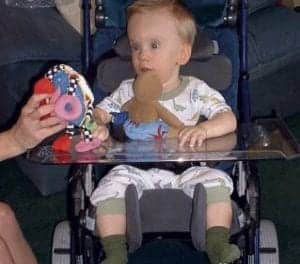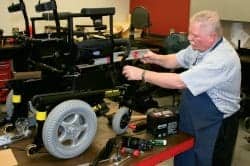 |
Pediatric and adult rehabilitation clients share many of the same concerns when it comes to choosing the mobility systems that work best for them. Skin integrity protection, maintaining optimal posture while managing discomfort, ensuring safety and function, and enabling independence are all vital issues that therapists must regularly address. For pediatric patients, though, additional consideration must be given to the physical aspects of their conditions.
MAXIMIZING INDEPENDENCE
The overriding goal when working with pediatric patients is to create a mobility system that works for them. The sooner they are independent—at the earliest age possible—the better. Whether that means utilizing a manual wheelchair at first or going directly into a motorized wheelchair, it is essential to achieve independent mobility as soon as possible.
Most children who do not have disabilities start walking around 1 year of age. There is some debate as to whether children with disabilities should be encouraged to manage on their own with no support for as long as possible, or whether they should have assistance. At the Wheelchair Clinic at Good Shepherd Rehabilitation Network in Allentown, Pa, the goal is to ensure that young patients have independent mobility as early as possible.
PROTECTING SKIN INTEGRITY
Therapists report that pressure sores are one of the most serious problems they see on the job. These areas of compromised skin integrity on a patient are the result of sustained pressure on various susceptible parts of the body. The pressure cuts off circulation, which impedes blood flow. Lower back, buttocks, shoulder blades, the lateral aspects of thighs and calves, as well as the backs of patients’ arms and legs are some of the more common areas where pressure sores may occur.
Another trouble spot is skin irritation caused by moisture from heat and/or bladder/bowel issues, which weaken the skin’s integrity. It is essential to provide a cushion/seating surface that addresses these issues to assist in the healing of current skin breakdown as well as to assist in preventing the development of skin breakdown on individuals who have susceptibility due to the above factors.
The evaluation and prevention of pressure sores are the same regardless of age. For pediatric patients in particular, though, preventing pressure sores requires some added attention, because children are still growing. Their changing bodies can impact their comfort overnight. A growth spurt or a sudden weight gain (or loss) can create havoc for a child whose wheelchair fit was appropriate, but who, due to a change in physical/functional status, now requires adjustments to their seating system to assist in ensuring optimal fit, function, and skin integrity.
The challenge for therapists with young patients is to identify trouble spots as early as possible. In some cases, healing a pressure sore may be just a matter of changing the seat cushion. But if a sore is not detected early, a patient can develop various complications, possibly leading to the need for medical attention at a wound center where the healing process can take months. Skin checks need to be done on a daily basis for someone who is at potential risk for skin breakdown. Bony prominences should receive particular attention as skin redness can indicate the beginning of the development of a pressure sore.
MAINTAINING OPTIMAL POSITIONING
The best way to avoid serious pressure sore issues—and to prevent future orthopedic deformities like scoliosis and pelvic obliquity among children—is to ensure the wheelchair fitting is done correctly from day one. Subsequently, regular inspections of the chair and child must be implemented. The last thing a therapist wants to facilitate or a young patient wants to endure is a setback caused by not practicing regular inspections.
Allowances must be made for growing bodies or other changes such as weight gain or loss caused by medication, for example. Children need a stable base to ensure the right support to enable them to perform functional tasks. Another factor that must be taken into account is that in many cases, younger children may not be able to advocate for themselves if something does not feel right.
For example, eating may require a different set of muscle skills than writing at a desk or playing at recess or drawing on the chalkboard. A child’s wheelchair must provide support to engage in each of those activities. Therapists need to be aware of the demands for each of these activities so that the chair can be adjusted accordingly from head to toe. Each of the following needs to be inspected at each visit:
- Headrest—should be at the appropriate height and offer appropriate support;
- Back support from bottom to top;
- Seat cushions—pressure-relieving cushions are necessary to aid in continued blood flow to lower back and buttocks;
- Trunk support (could include a chest strap, seat positioning belt, or lateral piece);
- Upper extremity support (could include armrests or a tray);
- Leg support—legrests and calf pads;
- Knee buttons—these ensure that the side of the thigh/calf does not come in contact with and potentially be injured by rubbing against the armrest assembly, legrest, or footplate;
- Pommel—which separates the legs;
- Footplates—they should be durable and angled properly.
If all of the above accessories are consistently in the correct position, it means we are providing children with the support they need to perform their daily functions of life. And doing this maximizes a child’s cognitive and social development, which benefits everyone.
ENHANCED SAFETY AND FUNCTION
Some childhood conditions have the potential to create an unsafe environment if not addressed immediately. One example is progressive neurological disorders like muscular dystrophy or spinal muscle atrophy types II and III, where children are able to walk initially but, as they grow older, begin to lose muscle strength and have a tendency to fall. These conditions should be monitored closely so that a mobility device can be put into place immediately before injury occurs. Or, for children who have done well in a manual chair to date, but are weakening as a result of the progressive nature of their disorder, consideration must be given to changing from manual to motorized functional mobility in the form of a motorized wheelchair.
Families who have children with autism often find that their children are independently walking and running in familiar and enclosed environments like their home or school. But problems may sometimes arise when these children are placed in a new social situation or when they are outdoors in open spaces where, due to their lack of safety awareness, a challenge is presented in keeping them safe. It is during these situations that a wheelchair may be helpful—it provides the parents with an option to enable their autistic child to participate in new activities while ensuring that safety is not compromised.
MAXIMIZING INDEPENDENCE
At the Good Shepherd Wheelchair Clinic, patients are encouraged to be as independent with their mobility as early in their life as possible. Whether that means making the transition from crutches to a manual wheelchair, or from a manual to a motorized chair, their potential for independence should not be compromised.
An 8-year-old girl named Christina, who has arthrogryposis, muscular dystrophy, and hypotonia, started out in a manual wheelchair at 22 months of age. But as she grew older, not only did she gain weight from medication side effects and normal growth, but the type of school activities she participated in became more physically challenging. Two of her favorite extracurricular activities, cheerleading and softball, required her to move faster and cover longer distances, and she could not keep up. She came home from school exhausted. By transitioning her into a motorized wheelchair with a seating system that accommodated her weight gain, she was able to participate in activities with her peers and still had energy left at the end of the day to finish homework and just “be” an 8-year-old girl.
CHALLENGES WITH PEDIATRIC PATIENTS
The three-way relationship among the child, parents, and therapist is a long-term one that evolves as the child grows and their needs change. The partnership between the therapist and the parents is vital to the physical, psychological, and social success of their child’s care. Often a therapist is challenged with addressing developmental issues with parents in a sensitive way. For example, if a toddler has been in an adaptive stroller (for conditions such as cerebral palsy or autism) but has grown out of it and must move on to a wheelchair, this is often a difficult transition for the parents. They don’t want their child in a device that looks “medical” and makes their child stand out as different from other children. So, while the child is ready to move on, often parents need convincing that while the look is different, the benefits to the child’s independence and mobility far outweigh the aesthetics.
Parents need to be fully educated on the safety features associated with wheelchairs and any other devices and know when it is appropriate to use one versus the other. Some children have only motorized wheelchairs at home and use manual wheelchairs at school and other activities.
Technology has improved so dramatically in recent years that there are more options than ever for young patients to thrive as independently mobile children, teens, and young adults. With the proper care and attention, children have the tools to manage their functional mobility on through adulthood.
Amy Kirkner, MPT, ATP, is a staff therapist and wheelchair clinic coordinator, and Patti Dworak, MSOT, OTR/L, ATP, is a staff therapist at Good Shepherd Rehabilitation Network’s Wheelchair Clinic, Allentown, Pa. For more information, go to www.GoodShepherdRehab.org.





